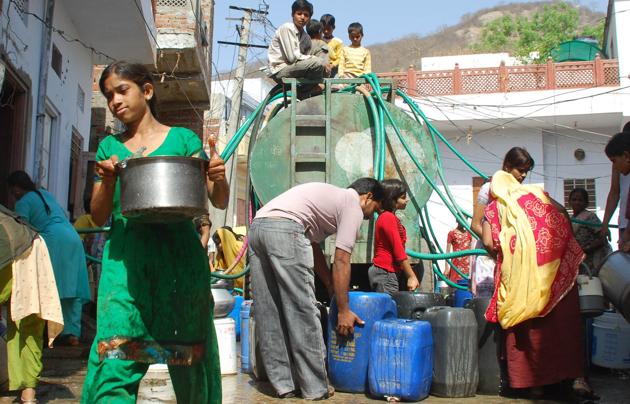Residents of Jaipur bank on water tankers as taps run dry
Officials say 35% of areas in state capital not connected with PHED pipelines.
Areas at the tail end of the colonies in Jaipur do not get regular water supply and when it comes, the pressure is so low that it is not even possible to fill a bucket, residents said.

Mohammad Shaheed (27), a resident of Bhatta Basti in Shastri Nagar area, said, “Most of the days, water hardly comes in taps and we are dependent on public health engineering department (PHED) tankers.”
Nupur Sharma (34), a resident of Gurjar ki Thadi area on New Sanganer Road, said, “The pressure of water is very poor and water hardly reaches the tanks on terrace. Many times, we buy water from private suppliers, who charge somewhere between ₹400-600 depending upon the demand.”
PHED additional chief engineer Jaipur region (II) Devraj Solanki said, “It is true that tail ends of the colonies do not get water, because water loses its pressure till it reaches there; the areas are situated far from the overhead tanks from where water is supplied. People also use boosters illegally, thus water does not reach the tail ends.”
Rasheed Khan Miyanji (48), a resident of Jalupura, said, “We are getting water supply daily, but pressure is so low that we are forced to use boosters to draw water. We fill the underground tanks and then lift water to the tanks on terrace with motor.”
He said on the eve of Eid on Tuesday, residents of Jalupura did not get regular supply in the morning and around 50 water tankers were purchased from private contractors at prices ranging between ₹300 and ₹500. “On Eid on Wednesday, residents complained to MLA Ameen Kagzi who spoke to PHED and water was supplied for two hours against the usual one-hour supply,” Miyanji said.
Solanki said the department has identified tail ends and water is supplied through tankers to the residents. He said 65% of Jaipur areas are covered with PHED pipeline supply; water is supplied through tankers to 35% areas not covered with pipeline. “We have placed 1600 PVC tanks with a capacity of 2000-4000 litres in such areas and slums; water is filled in these tanks daily through tankers,” he said. The uncovered areas in Jaipur city are Kho Nagorian area, Jagatpura, Jamdoli and some parts of Amer; even Prithviraj Nagar does not have PHED water supply, he added.
Water is supplied in Jaipur from Bisalpur dam and tube wells. The water level in Bisalpur dam is going down. The dam’s capacity is 32 thousand million cubic feet (tmc ft), while the usable water is 24.2 tmc ft; at present 3.4 tmc ft water is available, officials said.
People use coolers at homes in summers; each cooler on an average consumes more than 100 litres of water. As many people have 2-3 coolers at home, water consumption has increased during the summer. “At present 496 million litres per day (MLD) is supplied to Jaipur, of which 330 MLD is supplied from Bisalpur dam and 166 MLD from tube wells. On an average the demand of water per day in the city is around 550 MLD. Last year the supply was around 560 MLD as there was water in Bisalpur dam.” Solanki said.
The government has sanctioned digging of 279 tube wells in city areas, of which 254 have been dug up. Out of the 254 dug-up tube wells, 203 have been commissioned. In tail-end areas of the colonies and uncovered areas in the city, 453 tube wells were sanctioned, of which 271 have been drilled. Out of them 210 tube wells have been commissioned. “All the tube wells have to be dug up and commissioned by July 31 this year,” said Solanki.
He said water is being supplied daily for one hour at different timings. On action over illegal boosters, Solanki said, “Due to shortage of manpower and resources, not much action is being taken against people using boosters. Whenever PHED teams go to seize boosters, people get information and remove them, so very few are caught.”
He said, “People have to come forward in saving water, otherwise water crisis will always remain.”



